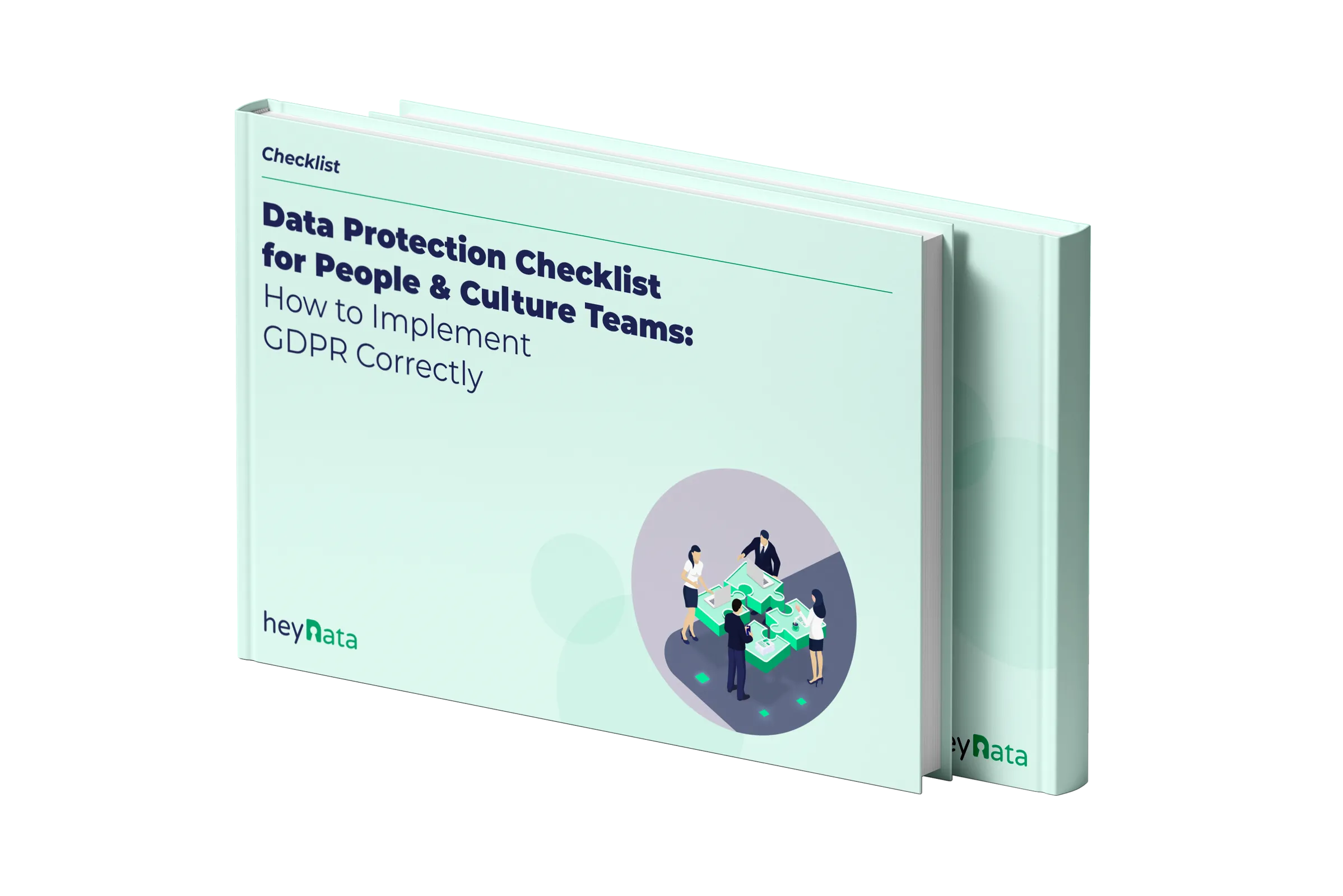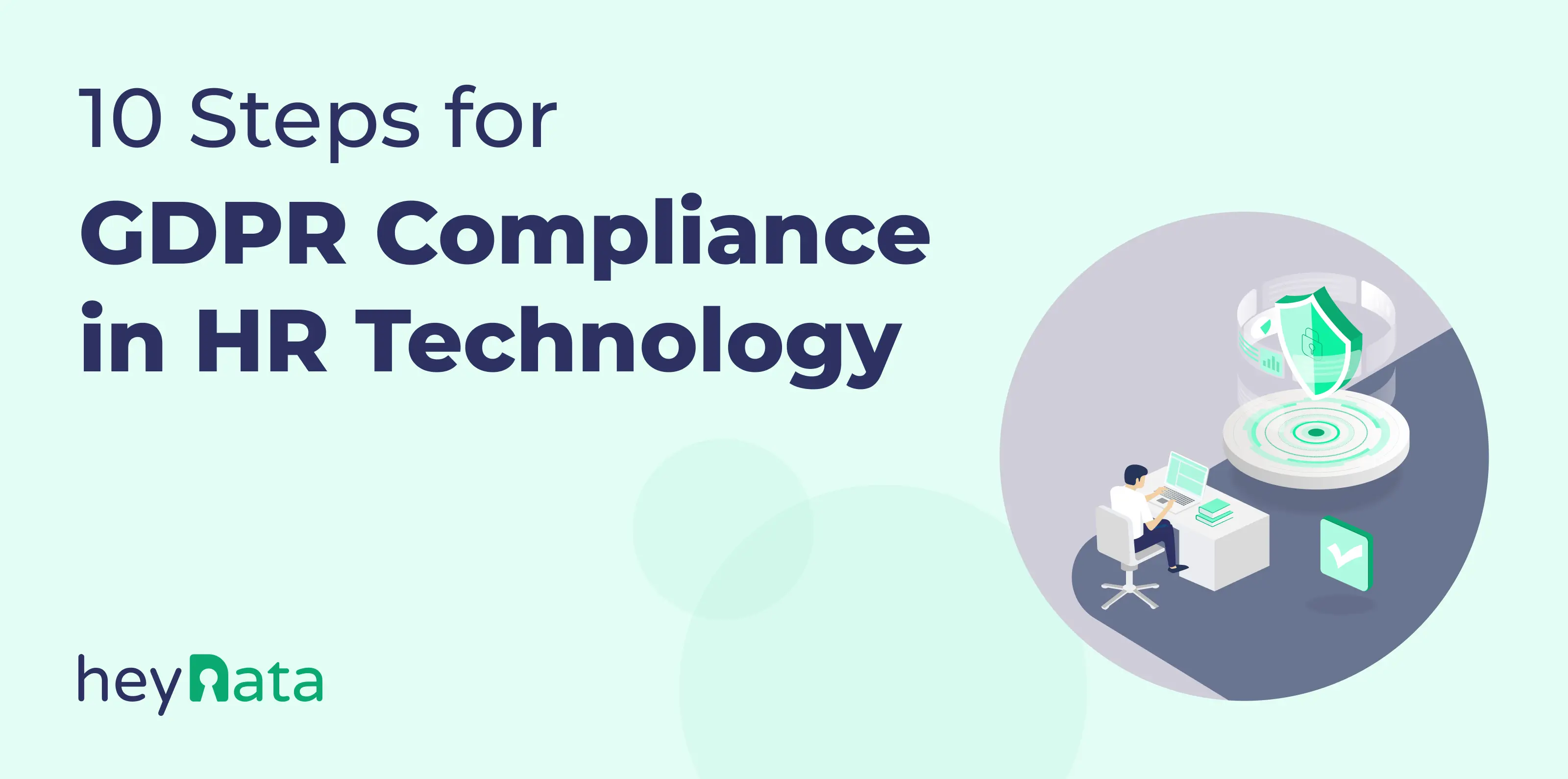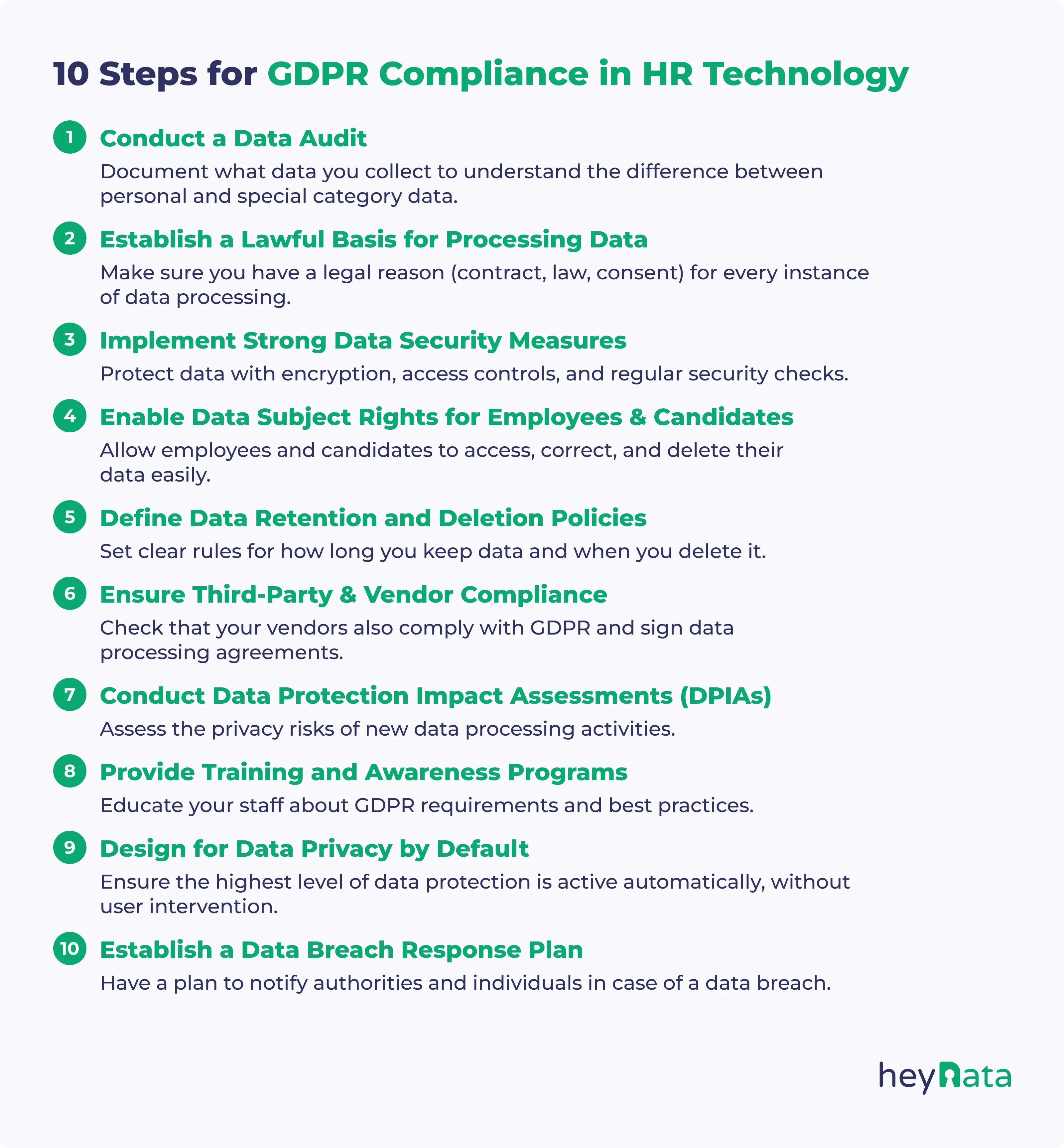
Ready to level up your compliance?

10 Steps for GDPR Compliance in HR Technology

'%3e%3cpath%20d='M26.6667%2020.022L30%2023.3553V26.6886H21.6667V36.6886L20%2038.3553L18.3333%2036.6886V26.6886H10V23.3553L13.3333%2020.022V8.35531H11.6667V5.02197H28.3333V8.35531H26.6667V20.022Z'%20fill='%230AA971'/%3e%3c/g%3e%3c/svg%3e) Key Takeaways
Key Takeaways
- Map and classify all HR data.
- Document lawful bases for processing.
- Encrypt and secure sensitive information.
- Enable employee data rights.
- Regularly audit and update compliance measures.
HR technology companies play a crucial role in the digital transformation of human resources, offering tools for recruitment, payroll, benefits, and employee management.
These platforms handle large volumes of personal data, often including sensitive information such as health records, salary details, background checks, and diversity metrics.
With the enforcement of the General Data Protection Regulation (GDPR), HR tech providers must ensure their systems and processes are fully compliant. GDPR compliance is not only a legal requirement - it’s essential to maintaining trust with clients, protecting employee and candidate rights, and avoiding substantial fines.
Non-compliance can result in regulatory investigations, costly fines (up to €20 million or 4% of annual global turnover), and significant reputational damage. For companies dealing with employee and candidate data, the stakes are even higher. Clients expect their HR systems to be secure, transparent, and fully compliant from day one.
In this article, we'll explore how HR technology companies can meet GDPR compliance requirements with practical, industry-specific steps to secure and process personal data responsibly.
Whether you’re building an applicant tracking system (ATS), HRIS, payroll software, or an all-in-one HR suite, these steps will help you embed GDPR compliance into the core of your product and business operations. Grab the full checklist at the end of the article!
Table of Contents:
1. Conduct a Data Audit
The first step in ensuring GDPR compliance in HR technology is to conduct a data audit.
Start by documenting what data is being collected and processed. HR platforms often handle:
- Personal data: names, contact details, employment history, payroll data
- Special category data: health information, disability status, biometric data, diversity data
Understanding the distinction between these types of data is critical. While all personal data must be protected under GDPR, special category data is subject to stricter requirements due to its sensitive nature. Processing this data usually requires a stronger legal basis, such as explicit consent or a legal obligation, and must be accompanied by additional technical and organizational safeguards, such as stricter access controls, encryption at rest and in transit, and limited access based on job roles.
For example, storing biometric data for employee access control or collecting health information for benefits eligibility involves heightened risk. If mishandled, this can lead to serious consequences for data subjects and significant regulatory penalties for the company.
Conducting a comprehensive data audit helps HR tech providers identify:
- Where data comes from (job applications, internal HR processes, third-party assessments)
- Why it's being collected (payroll, compliance, recruitment)
- How it flows through systems (between modules, integrated platforms, vendors)
- Where it's stored and for how long (e.g., cloud services, data centers, archives)
Data audits should include both structured data (e.g., database entries) and unstructured data (e.g., email attachments, uploaded documents). This is especially important in HR, where resumes, contracts, and scanned documents are common.
By conducting a thorough data audit and classifying data accordingly, HR technology companies can implement more targeted and effective protections.
2. Establish a Lawful Basis for Processing Data
Under GDPR, every instance of data processing must have a clear legal basis.
For HR technology companies, the most relevant legal bases include:
- Contractual necessity – Necessary for fulfilling employment agreements. For instance, payroll information is processed to ensure employees are compensated correctly.
- Legal obligation – Required to meet statutory requirements such as maintaining tax records or adhering to labor laws.
- Legitimate interest – Involves using data to further legitimate business interests, such as analyzing HR metrics for workforce optimization.
- Explicit consent – Particularly relevant in scenarios like conducting background checks where candidates must provide clear consent before their data is processed.
Each type of data may require a different basis, and the platform must be capable of handling and documenting these distinctions. For example, candidate data collected during a job application may initially rely on legitimate interest or consent. However, if that candidate is hired, the legal basis shifts to contractual necessity and legal obligation.
Employers also rely on HR software to help them stay compliant, so the platform needs to offer transparency and configurability.
As such, your system should be designed to separate and document multiple legal bases and store the appropriate consents and justifications for each data type. The system should also flag data that lacks a valid basis and restrict further processing until compliance is ensured.
3. Implement Strong Data Security Measures
Given the sensitivity of HR data, robust data security is non-negotiable.
Protecting employee and candidate information involves several key strategies:
- Encryption to secure data both at rest and in transit, preventing unauthorized access during storage and transmission
- Access controls, such as role-based permissions to limit data exposure based on job functions, ensuring only authorized personnel can view or edit information
- Regular security audits, including penetration testing and vulnerability assessments, to identify potential security weaknesses before they can be exploited
- Secure authentication, including multi-factor authentication (MFA) for all admin users
Companies must implement security by default, meaning that the highest level of data protection is active without requiring user intervention. This includes secure default settings for data access, password policies, and audit trails.
Data breach response plan is another critical security measure to implement.
In case of a data breach, GDPR requires notification of supervisory authorities within 72 hours. Additionally, affected individuals must be informed promptly to mitigate potential harm.
Breach response plans should be in place and tested regularly. HR tech platforms should also allow clients to assess quickly which records may have been exposed and automate notification workflows.
Including a well-defined incident response plan can also become a selling point for your software, as clients increasingly seek vendors that proactively manage risk and minimize potential exposure.
4. Enable Data Subject Rights for Employees & Candidates
Employees and candidates using HR technology platforms are entitled to exercise their GDPR rights.
These include:
- Right to access – view stored HR and recruitment data
- Right to rectification – correct outdated or inaccurate personal information
- Right to erasure – request deletion of personal data once it's no longer necessary
- Right to restriction of processing – pause data usage while a dispute is resolved
- Right to data portability – receive a structured, machine-readable copy of their data to transfer to another employer or system
- Right to object – especially relevant for data processed under legitimate interest
HR tech platforms must make it easy for their users (e.g., HR teams) to respond to these requests promptly - within the one-month timeframe required by GDPR. This includes verifying the requester’s identity, reviewing the data scope, and securely fulfilling the request.
As such, including an intuitive rights request dashboard or API can greatly enhance usability and reduce friction for your clients.
Since many HR tech platforms now include AI-powered tools for resume screening or initial candidate scoring, it's important to discuss the additional considerations this raises.
GDPR prohibits fully automated decisions that significantly affect individuals without human involvement, emphasizing the need for accountability. Candidates have the right to object and receive a human review if they face rejection due to AI-driven screening processes. This ensures fairness and transparency in recruitment practices.
For this reason, your HR tech platform must include this functionality:
- Mechanisms for human review
- Provide logs of automated decisions
- Allow users to contest or override AI-generated results
If used improperly, AI tools can expose both your HR tech company and your clients to significant compliance risks.
5. Define Data Retention and Deletion Policies
GDPR requires that personal data not be kept longer than necessary. HR tech providers must define and enforce data retention policies based on:
- Legal obligations – Certain employment and financial records must be kept to comply with tax laws, labor regulations, or social security reporting requirements. These legal mandates take precedence and often define minimum retention periods. For example, payroll records must be retained for 5–10 years, depending on the country or jurisdiction.
- Business needs – Some data is retained for operational purposes, such as maintaining employee performance reviews, facilitating internal mobility, or managing ongoing disciplinary actions. However, even in these cases, data must not be kept indefinitely.
- User consent – If a candidate consents to being considered for future roles, their data can be stored beyond the immediate application process. Consent must be freely given, informed, and revocable, and retention must be limited to a defined, reasonable timeframe.
As manual processes are error-prone and not scalable, your platform should offer automated deletion workflows to ensure that outdated or unnecessary data is securely removed on time.
However, retention settings should be transparent and customizable. Include automated notifications for HR teams before data is due for deletion.

Ready to level up your compliance?
6. Ensure Third-Party & Vendor Compliance
HR tech platforms rarely operate in isolation.
Most depend on a network of third-party services - such as benefits providers, payroll processors, cloud storage platforms, and analytics tools - that also handle personal data.
Under GDPR, these third parties are categorized as data processors, and the HR technology company that contracts them is considered the data controller, and remains ultimately responsible for any breaches or non-compliance.
This means that even if a data breach or compliance failure originates from a vendor, the HR tech company may still face penalties and reputational damage. Therefore, vendor management isn’t just a procurement or IT concern, it’s a critical part of GDPR compliance.
To ensure third-party and vendor relationships align with GDPR requirements, HR tech companies should take the following actions:
- Sign Data Processing Agreements (DPAs) with all sub-processors to clearly define roles, responsibilities, and safeguards.
- Vet third-party vendors for GDPR compliance, focusing on their data security practices, breach notification procedures, and data residency policies.
- Maintain a centralized, up-to-date list of all sub-processors and make it accessible to clients who need transparency for their compliance obligations.
- Implement a vendor risk management program, including regular audits, compliance reviews, and the ability to terminate agreements if vendors fail to meet standards. For HR technology platforms looking to streamline this process, heyData’s Vendor Risk Management solution offers structured support for evaluating and monitoring third-party compliance.
Many HR platforms also rely on U.S.-based services, such as cloud infrastructure providers or payroll integrations. Because GDPR restricts the transfer of personal data outside the European Economic Area (EEA) to countries without adequate protection, using these services often requires additional legal measures, such as Standard Contractual Clauses (SCCs) or assessing compliance with frameworks like the EU-U.S. Data Privacy Framework.
Staying compliant means actively monitoring legal developments and maintaining flexibility in your vendor strategy. If a framework is invalidated (as happened with Privacy Shield), HR technology companies must be ready to adapt their data transfer mechanisms without disruption.
7. Conduct Data Protection Impact Assessments (DPIAs)
Data Protection Impact Assessments (DPIAs) are a core GDPR requirement whenever data processing activities are likely to result in a high risk to individuals' rights and freedoms.
In practice, a DPIA is a structured process that helps organizations assess the potential impact of their data processing operations on individuals' privacy. It typically includes mapping the flow of data, evaluating the necessity and proportionality of processing activities, identifying risks, and planning mitigation strategies.
In the HR technology sector, DPIAs are especially relevant due to the volume and sensitivity of data being processed. From recruitment and onboarding to performance monitoring and benefits management, HR tech platforms often handle deeply personal information that, if mishandled, could lead to discrimination, reputational damage, or regulatory penalties.
DPIAs are particularly important in scenarios such as:
- Employee monitoring tools – Systems that track productivity, capture keystrokes, or use biometric access controls directly impact employee privacy and must be evaluated for proportionality and necessity.
- AI-driven recruitment – Automated resume screening and candidate ranking can influence employment opportunities. These systems must be assessed to ensure fairness, transparency, and accountability.
- Large-scale processing of sensitive data – Collecting and analyzing health data for employee benefits or wellness programs often involves special category data that carries heightened risks.
A well-structured DPIA should:
- Describe the data processing activity, its scope, and objectives
- Evaluate whether the processing is necessary and proportionate to its purpose
- Identify potential risks to the rights and freedoms of data subjects
- Recommend technical and organizational measures to minimize or eliminate those risks
One of the key challenges for HR tech companies is to strike a balance between workplace transparency and employee privacy. While tools that monitor or evaluate employee performance can offer operational benefits, they can also feel invasive. A DPIA helps ensure that any monitoring is justified, limited in scope, and accompanied by clear safeguards. Offering built-in DPIA templates or workflows within your platform can empower clients to carry out their assessments effectively and demonstrate shared responsibility in maintaining GDPR compliance.
Conducting a DPIA is not only a regulatory requirement - it is also a practical risk management tool. It encourages foresight in system design and builds confidence with stakeholders, including clients, employees, and regulators.
8. Implement Privacy by Design
GDPR requires companies to build privacy into their systems from the ground up. For HR technology, this means embedding compliance features directly into the software architecture.
For HR tech platforms, this means:
- Data minimization features, such as anonymizing or pseudonymizing candidate records after a position is filled
- Granular consent management, separating optional data from necessary processing
- Custom access controls, ensuring users only access data they need for their role
- Audit logs, tracking who accessed or modified personal data
- Privacy settings that default to the highest level of protection
By embedding privacy into the platform itself, you can help your clients comply effortlessly while also reducing your own liability.
However, since HR regulations vary across countries, HR platforms must be flexible and allow businesses to configure settings for local compliance needs. For example, data retention laws in Germany differ significantly from those in the UK or the U.S.
9. Appoint a Data Protection Officer (DPO)
Under GDPR, appointing a Data Protection Officer (DPO) is mandatory if the company:
- Conducts large-scale processing of special category data
- Systematically monitors individuals (e.g., employee activity, performance tracking)
HR technology companies are especially likely to meet one or both of these criteria. Given the nature of the software, often used to manage payroll, analyze employee performance, or monitor attendance - they frequently process large volumes of sensitive data. Additionally, features such as time tracking, productivity monitoring, or biometric access controls may constitute systematic monitoring under GDPR.
The role of a Data Protection Officer includes these responsibilities:
- Overseeing GDPR compliance
- Conducting audits and risk assessments
- Advising internal stakeholders on data protection
- Acting as the contact point for data protection authorities and data subjects
DPOs help ensure that compliance isn’t an afterthought but a built-in feature of your product and operations. A DPO can provide strategic advice, oversee risk assessments, and help navigate complex scenarios like cross-border data transfers or AI-powered recruitment tools.
With that being said, smaller HR technology companies may struggle to justify a full-time DPO. In these cases, they can outsource the role to a third-party compliance expert or legal firm, provided there is no conflict of interest.
Providers like heyData offer experienced external DPO services tailored to your needs, helping you stay compliant without the cost of hiring full-time staff. External DPOs bring specialized knowledge of data protection laws and industry best practices, and they can review your platform’s features, data flows, and documentation to ensure your software aligns with GDPR, particularly in complex areas like AI-driven recruitment, employee monitoring, or cross-border data transfers. They can also assist in conducting DPIAs, managing breach notifications, and representing your organization in dealings with regulators.
10. Provide GDPR Training & Awareness
Even the best-designed HR tech platform can fall short if internal teams lack GDPR knowledge. Training is critical to prevent accidental data misuse and to ensure a compliance-first culture.
There are two important layers of training and awareness to consider - your internal team and your client-facing features that help HR departments comply with GDPR. While these features are not strictly required under GDPR, offering them can significantly enhance your value proposition. Providing built-in support for client compliance needs can help your platform stand out from the competition and become a trusted partner in data protection.
Regarding internal training, your development, product, and support teams need to understand how GDPR affects the design and operation of your platform. This includes knowing:
- What constitutes personal and special category data
- How to implement privacy by design and data minimization
- How to handle security incidents and data subject requests
Providing regular GDPR training helps align your team around compliance goals and reduces the risk of unintentional non-compliance.
Clients using your HR tech software also need support in handling employee and candidate data responsibly. While you aren’t legally responsible for their compliance, you can empower them with helpful tools and guidance. Consider offering:
- Compliance toolkits and educational materials to HR departments using the platform
- Integrated GDPR guidance, such as prompts for setting retention rules or templates for DPIAs
- Onboarding checklists and reminders for customers to configure their privacy settings and DPAs
These initiatives not only support your clients but also enhance your platform's value. You can also consider partnering with an external provider such as heyData to offer professional GDPR training solutions.

Conclusion
HR technology companies operate in a sensitive and highly regulated environment. Unlike general SaaS providers, HR tech platforms process employee and candidate data that is often deeply personal and legally protected.
Ensuring GDPR compliance for HR technology means going beyond generic best practices. It requires careful data classification, clearly defined legal bases, robust security, and the flexibility to accommodate diverse labor laws and privacy expectations.
A proactive approach to compliance protects your business from legal risk while building long-term trust with employers and employees alike. As regulatory scrutiny continues to increase across the EU and globally, HR technology providers must stay ahead by embedding compliance into their products, processes, and company culture.
Seamlessly integrating GDPR safeguards into your HR platform can help you achieve these goals efficiently and confidently.
For this reason, heyData already offers 40 software integrations with industry-leading HR management platforms such as Google Workspace, Azure Active Directory, Microsoft Dynamics 365, Okta, Personio, BambooHR, and Workday.
With heyData, your existing HR systems integrate effortlessly - eliminating the need for manual data entry and significantly reducing the risk of human error. Adding or removing employees becomes a streamlined, automated process, freeing up time for your team and paving the way for advanced features like employee training and document management.
These integrations aren’t just about convenience - they’re built with security and GDPR compliance at their core. By connecting directly to leading platforms like Personio, BambooHR, and Workday, heyData helps you manage employee data efficiently, securely, and fully comply with legal standards.
Frequently Asked Questions (FAQ)
Q: What is a DPIA in HR technology?
A: A Data Protection Impact Assessment (DPIA) is a process to identify and minimize privacy risks in high-risk data processing, such as large-scale employee monitoring.
Q: What are the penalties for GDPR non-compliance?
A: Organizations can face fines up to €20 million or 4% of global annual turnover, as well as reputational and operational consequences.
Important: The content of this article is for informational purposes only and does not constitute legal advice. The information provided here is no substitute for personalized legal advice from a data protection officer or an attorney. We do not guarantee that the information provided is up to date, complete, or accurate. Any actions taken on the basis of the information contained in this article are at your own risk. We recommend that you always consult a data protection officer or an attorney with any legal questions or problems.


